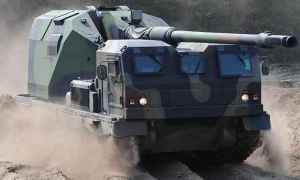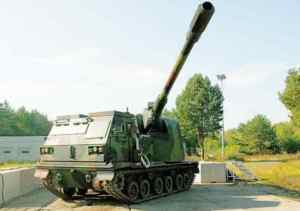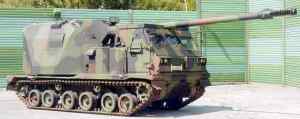| Designation: | DONAR AGM |
 |
|---|---|---|
| Manufacturer: | Krauss-Maffei Wegmann GmbH & Co.KG - KMW | |
| Product type: | Armoured Vehicles | |
| Name: | Self-propelled howitzer |
Late in 2004, Krauss-Maffei Wegmann revealed that it had built the prototype of a 155 mm self-propelled artillery gun based on the chassis of the US-developed Multiple Launch Rocket System (MLRS). This system is called the Artillery Gun Module (AGM) and has been developed as a private venture to meet the future potential operational requirements of the German Army.
To reduce development time and risk, wherever possible proven components have been used in the development of the AGM including the MLRS carrier chassis and elements of the PzH 2000, which is now in service with four countries.
In 2007 Krauss-Maffei Wegmann completed the verification phase of their 155 mm/52 calibre Artillery Gun Module (AGM).
Demonstrator 1 was completed in mid 2004 and used to verify the mechanical stiffness and strength of the gun module and its impact on the reinforced full tracked chassis.
During this period the weapon was fired by remote control with the chassis at different angles and the AGM positioned at different azimuth and the gun at different elevations.
Demonstrator 1 was the upgraded with the installation of a modified PzH 2000 projectile loader, new charge loader and a computerised fire control system based on PzH 2000.
Demonstrator 2 started its firing trials in the first half of 2006 and culminated in the firing of a volley of ten 155 mm rounds in 2 minutes and 19 seconds with a crew of two being seated in the fully armour protected cab.
So far over 1000 rounds of 155 mm ammunition have been fired from the AGM with many using the maximum of six Rheinmetall DM72 modular charges with its 155 mm/52 calibre ordnance.
It is understood that the German Army has a potential requirement for up to 41 systems with a production run from 2014 onwards with this date depending on funding.
As previously stated, this 155 mm/52 calibre AGM is based the proven chassis used for the US-developed MLRS, which is described in detail in a separate entry. Prime contractor for the carrier chassis is the now BAE Systems, Ground Systems (at that time United Defense).
The hull and cab of the 155 mm/52 calibre AGM is of all-welded aluminium armour that provides the occupants with protection from small arms fire, shell splinters and NBC attack. The system has a crew of two people. In the cab is the PzH 2000 ballistic fire-control computer with integrated NATO Artillery Ballistic Kernel and the Krauss-Maffei Wegmann Artillery Command and Control System.
Standard equipment includes an inertial reference unit with a GPS (Global Positioning System) connection. It also has a muzzle velocity measuring system that feeds information into the onboard fire-control system. Krauss-Maffei Wegmann claims that the AGM can engage moving as well as stationary targets. A vehicle independent auxiliary power unit is installed as standard and this allows the complete AGM to be run with the main MLRS carrier engine shut down.
Mounted on the rear of the chassis is an unmanned turret weighing 12.5 tonnes, which is armed with the same 155 mm/52 calibre ordnance, elevating mass and some loading subsystems (for example pneumatic rammer) as fitted to the PzH 2000 system used by the German Army.
A total of 30 155 mm projectiles and associated charges are carried and the range and ballistic performance of the AGM is the same as PzH 2000, as is accuracy and time in/out of action. Manual loading is also possible and multiple round simultaneous impact (MRSI) target engagements can take place.
Maximum range firing conventional ammunition is over 40 km (base bleed/rocket assist) but this can be extended to over 60 km using the Denel Munitions Velocity-enhanced Long-range Artillery Projectile (V-LAP) which has already been demonstrated fired from the PzH 2000.
The complete system has a combat weight of 30 tonnes and a transport weight of 27 tonnes which means that it can be transported in a new A400M transport aircraft. The actual AGM gun module only weighs 12.5 tonnes.
KMW are continuing to invest in the AGM in a number of key areas including improvements to the automatic loader to increase the rate of fire. This has already been increased to a 10 round volley in 1 minute 40 seconds in the simulation mode.
The actual AGM concept is fitted with the standard 155 mm/52 calibre barrel and fits the weight limits. Therefore, lighter barrels could be fitted if required by the customer with these including a 155 mm/39 calibre or even a 105 mm weapon.
To take account of the additional weight and firing stresses, the chassis has been structurally reinforced and fitted with stiffer torsion bars and extra shock absorbers have been added to assist the stability of the chassis.
Although the original application of the AGM was for installation on the standard tracked MLRS carrier chassis, Krauss-Maffei Wegmann is now studying a number of other applications. These include other tracked chassis, 6 × 6 and 8 × 8 wheeled chassis, a stand alone version and naval applications.
The stand alone version would consist of the complete AGM mounted on a substantial pallet with integrated auxiliary power unit which when deployed in the firing position would be stabilised by four outriggers. This would be a complete autonomous unit with the crew controlling the weapon system from a safe position. This would typically be used for base defence purposes.
Although the first example of the AGM is fitted with a 155 mm/52 calibre ordnance it could also be supplied fitted with a shorter 155 mm/39 calibre ordnance. This would have the same ammunition capacity but a shorter range.
|
||||||||||||||||||||
 |
 |
 |
 |
 |
